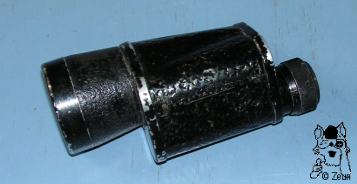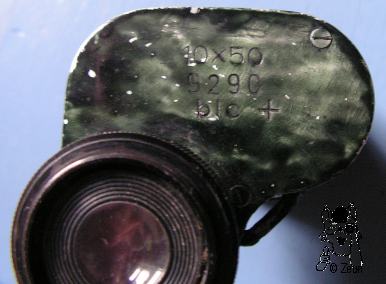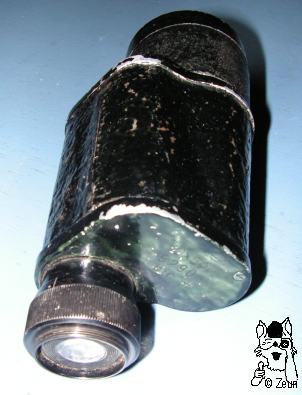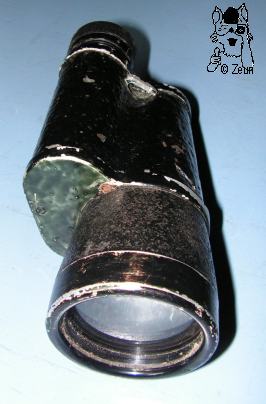blc 10x50
| Ob dieses Monokular nur die rechte Seite eines binokularen Dienstglases ist oder aus Materialmangel im 2. Weltkrieg direkt als Monokular gefertigt wurde, lässt sich nicht eindeutig sagen. Spuren einer abgesägten Brücke sind nicht sichtbar, das Gehäuse ist aber mit einem schwarz lackiertem Blech ummantelt, welches wohlmöglich nach einer Trennung beider Seiten nachträglich angebracht wurde. Der Deckel ist mit "10x50 9290 blc +" beschriftet, wobei der Code 'blc' für Carl Zeiss Jena zu beginn des 2. Weltkrieges, und das Plus für das Kältefett steht. Die Optik ist unvergütet. Der Objektitubs mit schwarzem Rauhlack ummantelt. Die Korpusteile sind aus Aluminium, die Augenmuschel fehlt. |
It is hard to say whether this monocular is only the right half of a bincoular "Dienstglas" (service glass) or whether is was made as this from scratch due to lack of material during WWII. There are no remains of a sawn-off bridge, but the housing is covered with a black painted tin plate, which might have been attached after such a seperation. THe cover plate is marked "10x50 9290 blc +": the code 'blc'v stands for Carl Zeiss Jena at the bgeinning of WWII, the plus sign denotes the cold protection grease. Optics are uncoated. The objective tube is covered with black crinkle paint, the body parts are made of aluminium. The eyecup is missing. |




| Das 10x50 wiegt 441g, es ist 157-168mm lang, das Gehäuse ist oben 63x63mm und unten 71x71mm breit, der 54mm lange konische Objektivtubus verbreitert sich von 53mm auf 61mm. Der Fokussierungsteil des Okulars ist 36mm im Durchmesser. | The 10x50 weighs 441g. It is 157-168mm tall. The housing measures 63x63xmm at it s top and 71x71 mm at its bottom. The conical objective tube is 54mm long and increases from 53mm to 61mm in diameter. The focusing part of the ocular has a 36mm diameter. |
Fotos: Zeun

